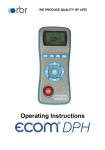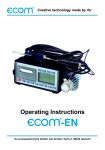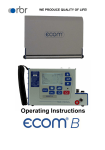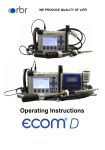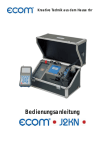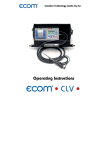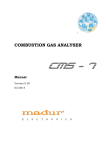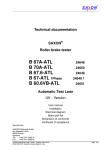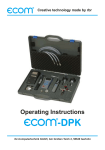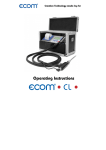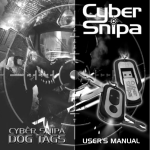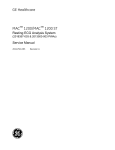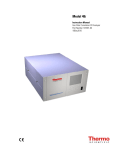Download Operating Instructions
Transcript
Creative technology made by rbr Operating Instructions rbr-Computertechnik GmbH, Am Großen Teich 2, 58640 Iserlohn Contents Page 1. Introduction 3 2. Equipment 4 3. Flue gas measurement 3.1. Flue gas analysis 3.2. Draft measurement 3.3. Soot measurement 3.4. CO measurement (flue gas check) 3.5. Storing and printing results 3.6. NOx measurement (NOx standard) 6 9 10 11 12 14 4. Data processing 4.1. Data base / RAM 4.2. Working with chip cards 18 23 5. Instrument settings 26 6. Servicing 27 7. Technical data 30 8. Software instructions 35 Page 2 ecom-JN 1. Introduction The ecom-JN is a combination measurement instrument for analysing flue gases and other combustion process parameters. The flue gas analysis is carried out using electrochemical fuel cells. Flue gas temperature, input air temperature, differential pressure, soot number and any values calculated from these values such as flue gas losses, efficiency and the excess air complete the list of results available and form the necessary parameters for the classification of small heating installation according to the 1st BImSchV. The rbr-ecom JN is the result of the many years of experience which many users have had with the ecom-J and J-Plus series and combines the highest possible safety requirements with user friendly operation and technology using the best, most modern circuitry in a future oriented design. The following instructions describe the simple operation of the instrument in the first, shorter section. This section should be read to avoid mistakes and problems when using the instrument. The servicing and maintenance information and the information on possible errors should also be read. The second, somewhat longer section describes the function of the processes used in the instrument and contains details on technical data. The instruction manual is set out to cover all possible options and so includes the NOx and data processing modules. Finally we would like to wish you every success in using the ecom-JN in your every day work. ecom-JN Page 3 2. Equipment Probes Pistol grip probe (Standard): - suitable for combined gas, flue gas losses, draftt measurement and soot measurement - Depth 290 mm - Diameter = 10 mm - Coaxial form with NiCr/Ni thermoelement (T-Gasmax. = 500°C) - Triple chamber tubing (3 m long) - Heated soot measurement point - Positioning cone Multi hole probe (Option): - CO measurement of gas burners - 3 meter tubing Heated sampling system (Option): - Heated tubing (100 °C; 3.5 m long) - Heated probe (100 °C) with 300 mm probe tubing and integrated NiCr/Ni thermoelement (T-Gasmax. = 200°C) - Hot gas filter Sensors T-room sensor (Standard): - Room temperature sensor with positioning magnet (T-roommax. = 99°C) Page 4 ecom-JN Standard fittings - Soot number comparison scale - Replacement filter - Case carrying strap - Operating instructions - Data sheet Optional extras - RAM cards (standard 512 kB) - Additional keyboard - Matrix printer instead of thermal printer - Peltier cooler instead of condensation trap - Probe holder (movable) - Undercase - Extended sensor on request Keyboard functions Contrast control Zoom <ZOOM> Display light Draft meas. <DRAFT> CO-sensor on/off ecom-JN Set menu Cursor <SET> up BImSchV Leave Paper line CO-meas. menu feed <MODE> <ESC> Print <PRINT> Control Cursor menu down <CTRL> Soot meas. Memory <SOOT> <m> Enter <E> Page 5 3. Flue gas measurement 3.1. Flue gas analysis After selecting the appropriate probe for the measurement, this should be attached to the measurement point and the temperature sensor for the input air should be positioned. Care should be taken to ensure that all tubing and connections between the probe and the instrument are correct. If a mains supply (230 V/50 Hz) is available nearby (mains cable is 5m long) it should be used. The instrument can be powered by the rechargeable batteries (when using a heated sampling system mains supply must be used). If needed a tube should be connected to the air input and an external air supply. A container for condensate should be placed near the condensation pump outlet which is on the lower right hand side of the instrument case. Switch on the instrument. Gas analysis Data bank/RAM Service card select, <E> confirm! Depending on the instrument either a menu appears on the display or, if there is no data processing software present, the 3 minute calibration phase starts immediately. To carry out a flue gas analysis, elect Flue gas measurement with the cursor and confirm by pressing <E>. The last selected fuel type will now appear in the display. The fuel type can be selected using the arrow keys to change the display to the fuel required and is selected by pressing <E>. select, <E> confirm! Calibration phase 2:59 min Fuel type CO2max Natural gas Natural gas Town gas Coke gas Liquid gas Oil 11.8 11.7 10.2 14.0 15.4 CO2max = 11,8 , A1 = 0,37 , B = 0,009 Page 6 ecom-JN If the data processing package has been installed the user is asked if the data base function is to be used. If "YES" is selected the data field type can be selected. This is explained in chapter "Data processing". Once the 3 minute calibration phase is completed the instrument is ready for measuring. The gas path inside the instrument is switched from fresh air to GAS and after a pause of approx. 20 seconds (the time for gas to reach the sensor) the complete measurement display appears. The display can differ depending on the sensors included in the instrument. rbr-ecom JN O2 17,5 CO2 10,1 CO 145 NO 38 Eta 92,3 Losses 7,3 10.09.94 % % ppm ppm % % Exc.air T.gas T.air Draft Dew p. 12:34 1,15 140 24 -0,05 49 °C °C hPa °C + Instruments with the NOx module have a separate display for NO, NO2 and NOx. The <ZOOM> key can double the display size, i.e. after pressing once the display changes from 8 lines to 4 lines. O2 CO2 CO Losses 17,5 10,1 145 7,3 % % ppm % The arrow keys can be used to alter the last two lines in the enlarged display (in this case CO and Losses). The upper lines can be changed by pressing the <ZOOM> key again, switching to a two line display. O2 CO2 17,5 % 10,1 % The last setting chosen remains so that the important values can be set in the display. ecom-JN Page 7 Please note: 1.) The measurement must be carried out in the main gas stream. The main gas stream is where T gas is at a maximum which can easily be found using the trend display. As long as a "+" sign is visible in the display the temperature being measured is rising, i.e. the probe is moving towards the centre of the main gas stream. A - sign means that the probe is being moved away from the main stream and the temperature is dropping. The display is deleted if no change occurs for 3 seconds or more. 2.) Correct measurements appear in the display after a short delay due to the time taken for the gas to reach the sensors and the time taken for the electrochemical sensors to reach a stable signal. This takes between 1 and 1.5 minutes. Measurements should not be saved, noted or accepted until the value has stabilised. If the values still vary by more than 2 ppm this could be due to an unstable draft behaviour in the flue gas which gives rise to a variable main gas stream. This can be confirmed by checking the draft value in the display. If this value varies strongly or is considerably bigger than 0.20 hPa this can effect the measurement. 3.) The values for CO2, Eta, Losses, Exc.air and Dew point are calculated. They can only be calculated correctly when realistic values for O2 and temperature are available. Care must be taken to ensure that: O2 < 20.5% T gas - T air > +5°C and The dewpoint can only be calculated accurately if the current barometric pressure was entered under <SET>. Once the measurements are stable and reliable press <m> to store the values in the memory. They can be stored here for printing out at a later stage. Page 8 ecom-JN 3.2. Draft measurement The draft present in the flue gas channel has already been indicated by the trend display earlier. The chimney draft value is not stored by pressing <m> as the differential pressure sensor is very sensitive and drifts. For this reason it is recommended that the sensor be re-calibrated immediately before a measurement to ensure a good accuracy. A differential pressure measurement is started by pressing <DRAFT>. The current value is displayed as well as a reminder to reset the sensor zero. To do this, remove the draft tubing and press the <MODE> key. The sensor will now be re-calibrated. Draft measurement Draft - 0,05hPa Reset zero point : release draft hose, then press <MODE> ! Replace the tubing. The display now shows the exact value which can saved value : -0.08 hPa now be stored by pressing <m> which adds this value to those already stored. The value saved is displayed. To leave the draft measurement press <ESC>. ecom-JN Page 9 3.3. Soot measurement A soot measurement is started by pressing <SOOT>. A soot measurement on an oil fired system consists of three suction phases in which a volume of 1.63 (+/- 0.07) litres is drawn in. The colour (greyness) of the soot filter disk is graded according to the 10 level Bacharach scale. S o o t smoke no.1 m e a s u r e m e n t smoke no.2 _ . _ _ . _ oil trace: ___ smoke no. 3 _ . _ Mean value: All three individual measurements are recorded. We recommend that the soot measurements are heated to avoid the filter paper becoming wet from the condensation which will effect the colour of the soot deposited. The filter paper assembly in the probe is heated to 70°C. Electric soot measurement with the ecom-JN Switch on the heating for the sampling probe by pressing <SET> and moving the cursor to “Probe heating NO” and pressing <E> to change it to "YES". <ESC> leaves the menu. Place a filter disk into the holder in the probe and press <E> to start the measurement. The volume drawn is displayed and once 1.63 litres has been reached the greyness value must be entered. To do this remove the filter paper from the holder and compare it with the colours on the scale. If a greater accuracy is required a densitometer (reflection photometer) can be used which gives a value accurate to one decimal place. Enter the result and confirm with <E>. The cursor now moves to the second soot measurement. Repeat this procedure until all three soot measurements have been completed. The cursor has now moved to the oil derivative display. <E> switches between “YES”, “NO” and “—”. The average is calculated and automatically stored. Pressing the <ESC> key ends the soot measurement. Press <SET> to switch the probe heating off as the previous settings are stored and would cause unnecessary drain on the power supply when using the batteries. Page 10 ecom-JN Manual soot measurement and entering the values If the soot measurement is carried out manually using a hand held soot pump to reduce the load on the sensors, the results can be placed in the instruments memory. The soot measurements are added to the printer report and to the data for the measurement. Press <SOOT> and then <MODE>. Type in the smoke number (decimal point using the arrow key) and confirm with <E>. Repeat twice more and then continue as described above. The values are stored automatically. 3.4. CO measurement (flue gas check) When testing the safety of a gas fired incinerator a flue gas path test, often called a CO measurement is carried out. The CO content of the flue gas is measured after the flow restriction and the undiluted value (0% oxygen remaining in the flue gas) is calculated. The flow of flue gas after the flow restriction is no longer homogenous due to secondary air flow and so the main stream measurement will contain errors. The analysis of the gas therefore is carried out using a multi-hole probe (optional extra). Align the holes of the multi-hole probe against the flow direction in the gas stream. Press the <MODE> key and the 4 values required for a CO measurement are shown in the display. The value shown after CO(U) is the calculated CO content assuming the oxygen content is 0%, the undiluted CO concentration in the flue gas. O2 CO (U) CO Exc. air 17,5 % 738 ppm 123 ppm 1,03 Once the display is stable press the <m> key to store the value. Press <MODE> to return to the standard flue gas measurement mode. ecom-JN Page 11 3.5. Storing and printing results The rbr-ecom JN has a 58 mm thermal printer for printing reports (optional matrix printer). The printed report can be used as a copy of the work carried out for the customer or as an archive copy of the measurements. A report is printed by pressing <PRINT> and contains only those values stored in the memory at that time. A described earlier the individual measurements are stored by pressing <m> (the soot measurement is stored automatically). Once <PRINT> has been pressed the stored values can be checked. The report is printed by selecting “Start print”., and is structured as follows : Customers name and address form the data ecom-JN base (only appears if the relevant options have been selected or installed) name 1 name 2 text (2 lines each 20 characters long) line 1 comments, notes, information... date and time of report result from flue check flue gas analysis results according to BImSchV NO, NO2, NOx only shown if option installed Differential pressure measurement soot measurement results 8 lines of text each max. 20 characters in length which can be programmed according to the customers requirements either before delivery or at a servicing (e.g. firm address) Page 12 line 2 Date Time 12.09.94 12:34:56 CO-measurement O2 17,5 % CO (U) 738 ppm CO 123 ppm Lambd. 1,15 BImSchV Fuel type Heating oil T air 22 °C T gas 140 °C O2 13,2 % CO 85 ppm NO 43 ppm NO2 5 ppm NOx 48 ppm Draft -0,05 hPa Smoke no. 1,2 1,3 1,4 Oil derivative No max. 8 lines of 20 characters (name, adress, telephon, text,...) ecom-JN Text input lines 1 and 2 In certain cases it can be useful to include additional comments in the report (notes, comments, observations, etc.). This can be achieved by selecting “Text input” with the cursor and pressing <E> : Insert text • • Cancel with <ESC> ! delete with <F2> ! Two lines each 20 characters in length are available for inputting any information required. An external keyboard is available as part of the data processing package, without this keyboard only numeric data can be entered using the internal keyboard. Whilst the report is being collated and printed all other functions are inoperative. Note: The memory contents can be deleted by pressing <m> in the appropriate mode (BImSchV measurement, CO measurement or draft measurement). The "m" in the display disappears and the values in the memory are deleted without being over written with by any current results. To store the current values , the <m> key must be pressed again and the "m" appears in the top right hand corner of the display again. ecom-JN Page 13 3.6. NOx measurement (NOx standard) The ecom-JN can be equipped with a complete NOx module which comprises: - NO sensor - NO2 sensor - peltier cooled gas heat exchanger - heated sampling system (3.5 m long) The instrument can also be equipped with only one sensor for measuring the NO concentration although no NOx calculation can be made in this case. NOx is made up of the sum of the NO and NO2 concentrations in the flue gas which depend on the fuel and the combustion process. Legal limits and recommendation always refer to the sum of nitrogen oxides (NOx). Under normal conditions NO2 is very reactive and will be washed out by condensation to form nitric acid (HNO3). For this reason the gas path from the measurement point to the instrument must be kept condensation free to avoid washing out off NO2. The heated sampling system heats the head of the probe and the tubing to a temperature (standard 100°C) above the water condensation point (this is normally between 45 and 60°C) and so prevents condensation forming. The peltier cooled gas heat exchanger shock cools the gas down to a temperature of between 5 and 8°C. This causes excess water and water vapour which can no longer be kept in the gas at this temperature to condense out. The condensation is collected in a container underneath the cooler and can be removed by pumping out either as required or automatically when the instrument is switched off. Page 14 ecom-JN The gas is in the tubing for such as short time and is unable to react or cool down any further on its way to the sensors so no further condensation occurs. The nitrogen oxides are measured separately using two sensors. Both values are displayed and dealt with separately. Their sum is calculated according to the conditions set : NOx in ppm NOx (ppm) = NO (ppm) + NO2 (ppm) NOx in mg/m3 NOx (mg/m3) = (NO (ppm) + NO2 (ppm)) * 2.056 NOx in mg/kWh Calculated from tables according to TA-Luft and the fuel type. The conversion factors for the individual gases are in the appendices. Please note the following when measuring nitrogen oxides: 1.) Use the heated sampling system. Measurement carried out using the normal sampling system without the gas cooler can have an error due to up to 40% of the NO2 concentration being washed out. 2.) The heated sampling system can only be used with a mains power supply. The power consumption is approx. 400 W. 3.) The set temperature is reached after approx. 5 minutes and is then controlled by the programme. 4.) Be sure to connect the condensation tubing when using the heated sampling system and gas cooler to avoid problems due to condensation being pumped off. ecom-JN Page 15 4. Data processing The ecom-JN data processing package consists of : - RAM card slot - Extended software - External keyboard - Centronics parallel port - Optional: RAM cards in different sizes (standard 512 kB) The extended software enables additional functions for storing and administrating measurement results as well as long term measurements with data logging. Data processing with the no consists of two different methods: 1.) Processing of individual measurements and installation data. This data can be stored on an external data carrier for processing at a later stage. The data is stored in a standard format compatible with PC data formats and existing software (e.g. regional administration programmes, data bases). 2). Processing of long term measurement data with automatic recording (data logger). The instrument records all measurement data over a time period at programmable intervals or sends them via the serial and parallel ports to a PC or printer. The preferred data carrier is again the RAM card (if a PC is connected the data can be written directly to the hard disk). The data processing functions (other than those connected with recording measurement data) can be used when the instrument is not measuring. The pump and the sensors remain switched off and no calibration is carried out when the instrument is switched on. Page 16 ecom-JN 4.1 Data base / RAM The JN uses RAM cards as storage medium for large amounts of data. RAM cards with capacities up to 4 MB (4096 kB) can be used. As with floppy disks in a PC, a RAM card must be formatted before it can be used. The formatting procedure deletes all of the data previously stored on the card and is irreversible. Approx. 1 kB is reserved on the card for system information. RAM cards are formatted by choosing the option “RAM card” from the menu. Select Visualize/Print Communication RAM card A list of further options appears along with information on the RAM card. Format Cancel files Configurate Capacity Reserved 512 kB 250 kB General Data 0 Free 261 kB Select “Format” and after the warning message has been confirmed the RAM card is formatted. Once the formatting is finished the main menu reappears. Note : The standard setting for RAM cards is 512 kB, if RAM cards of different capacity are used this must be set under “Configurate” as otherwise the card will be incorrectly formatted. The RAM cards can be used for storage and for data base functions. With the data base function, data is loaded from a PC (e.g. installation data, customer data) and the measurements are added later in situ. Once the measurements are completed the data can be relayed to the PC in the correct form and under the correct area. To do this an area of the RAM card must be reserved. ecom-JN Page 17 The rest of the card can be used for other measurement data which does not need to be stored under a specific installation, e.g. when using the data logger function. Select “Configurate” from the menu. Two lines appear in the display: - Total 512 kB - Reserved 256 kB “Total” determines the total capacity of the RAM card. If this is different from 512 kB press <E> to set the correct capacity. The values shown are those for acceptable RAM cards. The reserved area is set similarly by moving the cursor to “Reserved” and pressing <E> until the desired value is reached. The reserved value is increased in steps of 64 kB. Once the settings are correct press <ESC> to leave this menu. “Cancel files” does not need much explaining. After the warning has been answered with “YES”, all files on the card are deleted. Warning: Due to the read / write mechanism used with RAM cards accidentally deleted files cannot be recovered. The delete and format functions should therefore only be used after the data on the card has been copied onto a PC. Communication Once the RAM card has be prepared it can be used. The option “Communication” accesses the functions load data base, send data base and general data transfer. The options are selected with the cursor and <E>. Load data bank Data is transferred from the PC via the RS 232 port from a particular programme (e.g. the regional administration software). To do this the RS 232 port on the ecom-JN is connected to the serial port on the PC. C o m m u n i c a t i o n Load data bank Send data bank Send general data Page 18 ecom-JN Data is transmitted according to the instructions given in the programme on the PC. The data transfer must also be confirmed on the JN before transferring. The reserved area on the card is formatted differently in a few seconds (progress is shown on the display). The JN is then ready to accept data from the PC. The functions “Select” and “View / Print” are now available. The “office work” with the JN is now finished and the JN can now be used for actual measurements. The decisions whether to use a data base and which storage medium to use are made after switching on the instrument. The settings for storing general data on RAM cards are found under "Set menu" (<SET>, function “times” and “data logger : YES”). Send data bank Connect the JN and the PC via their RS 232 ports and start the programme and follow the instructions. Chose the function “Send data bank” on the JN and press <E>. C o m m u n i c a t i o n Load data bank Send data bank Send general data The data will be sent to the PC. The data base on the RAM card contains information on changes made which means that only data corresponding to actual measurements are transferred. If there is general data in the reserved area on the RAM card which is to be transferred to the PC (e.g. measurements from the data logger) the RAM card data programme should be used. Connect the PC and JN via the RS 232 port. Start the programme on the PC. Set the required options on the PC and press ENTER. On the JN select the function “Send general data” and press <E>. ecom-JN Page 19 Select and View / Print The functions “Select” and “View / Print” can be used for checking the measurement results and printing them out. Select the data to be viewed by entering a search pattern (e.g. the name of a distributor) or a customer number or memory number. If no data can be found, check the search pattern to see if it is correct. The complete data base is searched and data retrieved when at least 4 characters are in agreement with the search string. Once the search is completed the data is displayed and can be confirmed or re-selected. “View / Print” can be used to view the entire contents of the memory and print them out. 4.2. Working with chip cards Only for instruments with chip-card-slot! The rbr-ecom JN can read from and write to 512 byte chip cards. These data carriers which look like telephone cards, can store approx. 500 characters of information. A chip card can be used as a installation data card, a measurement file or as a job card. Service card data Meas. values Record -> MC Report The cards memory is divided into two areas : - standard data - measurements Page 20 ecom-JN Standard data Standard data are data describing an installation : - Owner (max. 60 characters) - Customer number (max. 20 characters) - Burner manufacturer (max. 20 characters) - Burner type (max. 20 characters) - Year of manufacture (max. 10 characters) - Fuel type (max. 20 characters) - Hu (kWh/m3) (max. 6 characters) - Jet size (max. 9 characters) - Jet pressure (max. 6 characters) - Boiler manufacturer (max. 20 characters) - Boiler type (max. Characters) - Year of manufacture (max. Characters) - Nominal performance (kW) (max. 11 characters) - Set performance kW) (max. 6 characters) This data is either on the card if it has been prepared previously or it can be entered directly into the ecom-JN using the keyboard if the chip card is to be prepared during servicing or installing. The standard data required is fixed as is the length of the data areas. If a chip card is put into the ecom-JN the data is read from the card into the instruments RAM. Measurements The measurement results contain all of the information from a measurement. If a chip card has been inserted into the ecom-JN and the <m> key is pressed the results are transferred form the instruments RAM to the chip card. Any data already on the chip card is over written. ecom-JN Page 21 Store > MC If the chip card is used as an installation card it generally remains with the heating installation with the data stored on it. The data can be transferred to a RAM card and then to a data processing system for general processing or report generation. This is done by selecting “Store >MC” with the cursor (MC means memory card) and storing the data on the un-reserved part of the RAM card (general data). Report In many cases it is necessary to store additional information along with the measurement information already available. Up to now the data processing and handling using the rbr-ecom JN has been done without paper using the most modern techniques. It is therefore only natural that any additional information be handled in the same way. Select “Report” with the cursor, a blank display screen appears which can accept up to 280 character from the external keyboard. 7 x 40 charakters of text can be entered Report Delete <F2>! There are no restraints on the text which can be entered and it is stored as written in the instruments RAM. The function “Store >MC” transfers the text along wit the chip cards contents to the RAM card. Once the JN is switched off all of the data in its RAM are deleted, only data stored on RAM cards or chip cards remains. Page 22 ecom-JN 5. Instrument settings The ecom-JN functions are described in the previous sections. The calculated and measured values can be altered by changing certain options via the settings on the JN. Pressing <SET> when in the flue gas measurement mode accesses the options menu. Move the cursor to the relevant position and press <E>. E i n s t e l l u n g e n Unit ppm Undiluted Nein Refe.-O2 0,0 % Boiler temp. Air pres. 1013 mbar Probe heat. No Fuel Clock set Fuel ty. <- PC Times Data logger No The following settings are possible : Unit - Factor for calculating gas concentration in: - ppm = volume concentration (parts per million) 3 - mg/m = mass concentration per volume - mg/kWh = mass concentration over output Undiluted - Calculation of gas concentration using reference oxygen YES/NO Formula for calculation : Erel = Emeas * 21 - O2rel 21 - O2meas Reference O2 - input reference oxygen value O2rel Boiler temp. - input boiler temperature Air pressure - barometric air pressure used in the dew point calculation (see appendix) ecom-JN Page 23 Probe heating - soot probe heating on/off Fuel - change the fuel type (e.g. when measuring on combination systems) Clock set - set the internal clock Fuel type <- PC - changes the fuel type menu in the instruments EEPROM by accessing PC data via the RS 232 port. Times - set the memory and output options for sending data to RAM card and Centronics port Data logger - switch the data output and storing on or off 6. Servicing To ensure interruption free use of the rbr-ecom JN please take note of the following information for servicing and maintaining parts : Filter The JN is equipped with filters to protect the tubing and sensors and these need to be checked regularly : Fine dust filter on the gas cooler Unscrew the lid of the gas cooler and check the particle filter. It should be changed when the filter is dark grey to black in colour where the gas comes in (smoke number approx. 2 - 3). Page 24 Fine dust filter ecom-JN Filter in the heated probe (only applies to instruments with the heated sampling system) Important : Always remove the mains connection before opening the probe (the heating requires 230 V) Open the bayonet fitting on the probe and remove the filter if it is dark grey in colour. The filter used is a 8 m boron silicate glass fibre mat. SO2/NOx filter In the tubing leading to the CO sensor on the rear of the instrument is a chemical filter for filtering SO2 and NOx out of the flue gas. The filter material is manganese-4-oxide granules and should be changed once it has turned grey (colour change: pink>brown>black>grey>white). Sensors After switching on the sensors are calibrated with fresh air. The instrument constantly checks the sensor status. New sensors age due to the reagents being used up (oxygen sensor) or due to dirt or being exposed to concentrations above their standard rang (toxic gas sensors). The initial values for sensors in check mode are: Oxygen sensor toxic gas sensor approx. 18,000 mV 0 mV (+/- 150) These values are relative values created by the programming. The check mode <CTRL> for the toxic gas sensors should show a value < +/- 150 mV, if not the calibration should be repeated. If an error occurs during calibration and does not disappear after repeating the calibration several times the instrument should be sent in for servicing. The oxygen sensor should read > 7000 mV. If this is not the case it should be exchanged. Probe and tubing The tubing and the probe should be cleaned regularly, depending on use, to remove dirt and to avoid wear due to corrosion taking place. The coaxial probe can be dismantled by unscrewing the outer tube. The inner tube is connected to the grip. The thermo-element is permanently attached to the grip. The tubing can be cleaned after removing it from the connections on the instrument and probe (use warm water and allow to dry or blow dry). ecom-JN Page 25 Power supply A rechargeable battery is used for mains free operation. The battery has a capacity of 3,4 Ah and the length of use depends on the operating mode (approx. 1 hour with gas cooler and internal heating with heated soot measurements). The battery is recharged by plugging the instrument into the mains (charge time approx. 10 hours). Switching on is not necessary. The battery should be recharged once the voltage display reads less than 11 V (the critical point is 10.5 V after this the instrument will not function). The battery voltage is only displayed when the instrument is not using the mains supply. 7. Technikal data General data Power supply mains 220 - 240 V / 50 Hz battery 12 V / 3,4 Ah (lead gel) Battery operation > 1 hour with full load low charge protection 10.5 V Charge time approx. 8 - 10 hours charging current limit over charge protection Power consumption max. 100 W without heated sampling system and gas cooler approx. 400 W with heated sampling system and gas cooler Optional extras - heated sampling system (Tmax. 100°C: length 3.5 m) with heated probe and pre-filter (hot gas filter; T gas max. = 200°C) - RAM card data carrier (Standard 512 kB; PCMCIA-norm) - case for additional equipment Dimensions Case (W x L x H) Weight Page 26 :450mm x 300mm x 250mm :approx. 12 kg with standard probe 300 mm ecom-JN Measured values Parameter Range Principle O2 CO NO (Option) NO2 (Option) CO% (Option) Draft T-Gas T-Air 0 ... 21 Vol.-% 0 ... 4.000 ppm 0 ... 2.000 ppm 0 ... 200 ppm 0 ... 10 Vol.-% 0 +/- 20 hPa 0 ... 500 °C 0 ... 99 °C Electrochemistry Electrochemistry Electrochemistry Electrochemistry Electrochemistry DMS-bridge Thermocouple NiCr/Ni Semi-conductor Calculated values Parameter Range CO2 0 - CO2max CO2= CO2max* 0 - 99,9 % qA = Losses Formula ( A2 21 - O2 ( 1- O2gemessen 21 ) ) + B * ( TAbgas - TLuft ) Efficiency 0 - 99,9 % ETA = 100 - qA Excess air 1-∞ λ = 1+ O2 21 - O2 Fuel types Fuel Fuel oil Natural gas Town gas Coke gas Liquid gas ecom-JN CO2max values and factors A1 A2 B 0,50 0,37 0,35 0,29 0,42 0,68 0,66 0,63 0,60 0,63 0,007 0,009 0,011 0,011 0,008 CO2max 15,4 11,8 11,7 10,2 14,0 Page 27 Conversion factors (ppm - mg/m3 - mg/kWh) Gas ppm to mg/m3 mg/m3 to ppm fuel type CO NOx SO2 O2 CO NO NO2 SO2 0,699 0,8 0,75 0,49 0,35 Nat. gas L Nat. gas H Propan Town gas Oil EL Oil S 1,092 1,073 1,05 1,002 1,105 1,12 1,795 1,762 1,722 1,647 1,816 1,847 2,587 2,63 1,429 1,25 1,34 2,05 2,86 Dew point calculation The dew point calculation uses the approximation given in DIN 4705 part 1. χ H2 O = Moisture content of the gas fw is a fuel factor 100 + 11 . fW 1+ CO2 in % gas = 57 town gas = 53 liquid gas = 77 oil = 111 PD = χ H2 0 * Pair in Pa 4077.9 − 236.67 23.6448 − ln PD in °C Partial pressure of steam calculation 100 Pair = atmospheric air pressure (900 ... 1100 mbar) Dew point calculation Page 28 TP = ecom-JN Gas cooler (schematic) Gas in Gas out Peltier element Level indikator Condensation removal Ventilator Gas at a temperature above the steam condensation point (35 - 65 °C) passes through a long, surface treated metal spiral with good heat conducting properties. The gas losses its heat to the metal. A direct current driven peltier element (semi conductor cooling element) is thermal connected to the metal spiral and to another spiral with ventilation and cooling fins. The current flowing through the peltier element causes a heat transfer from warm to cold thus removing the warmth from the gas flowing through the spiral and transfers it to the cooler. This warmth is then removed by the ventilator. The condensation formed by the gas cooling is collected in a container below the cooler and periodically pumped off using a peristaltic pump (triggered by the operator or by the level indicator). The gas suction pump prevents the gas from remaining too long in the presence of condensation and so reduces any losses due to washing out reactions. The gas temperature on leaving the cooler is approx. 5 °C with a relative humidity of approx. 100% (water vapour fraction < 7 g/kg). ecom-JN Page 29 Coaxial probe 6 1 7 2 1. Inner tube (gas) 2. Outer tube (draft) inner Ø = 6 mm outer Ø = 8 mm inner Ø = 9 mm outer Ø = 10 mm 8 3. Draft connection (3 ribs, same on instrument) 4. Gas connection (2 ribs, same on instrument) 5. Connection for T gas 6. Temperature sensor for T gas (NiCr/Ni, not visible) 7. Slot for soot filter with pressure piston 8. “Trigger” for the piston. 3 4 5 The probe can be dismantled for cleaning : 1. Unscrew the outer tube (draft) form the grip and remove it. 2. The inner tube (gas) can now also be removed (sealing o-ring). When reassembling care must be taken to ensure that the thermal wire tip does not touch the tube. Page 30 ecom-JN Subject to technical changes 12.2004 rbr Computertechnik GmbH Am Großen Teich 2 D-58640 Iserlohn (Sümmern) Telefon: +49 (0) 23 71 - 9 45-5 Telefax: +49 (0) 23 71 - 4 03 05 Internet: http://www.rbr.de eMail: [email protected] ecom-JN Page 31
































